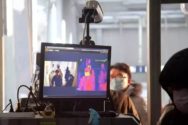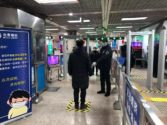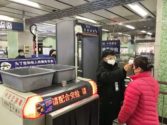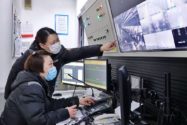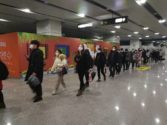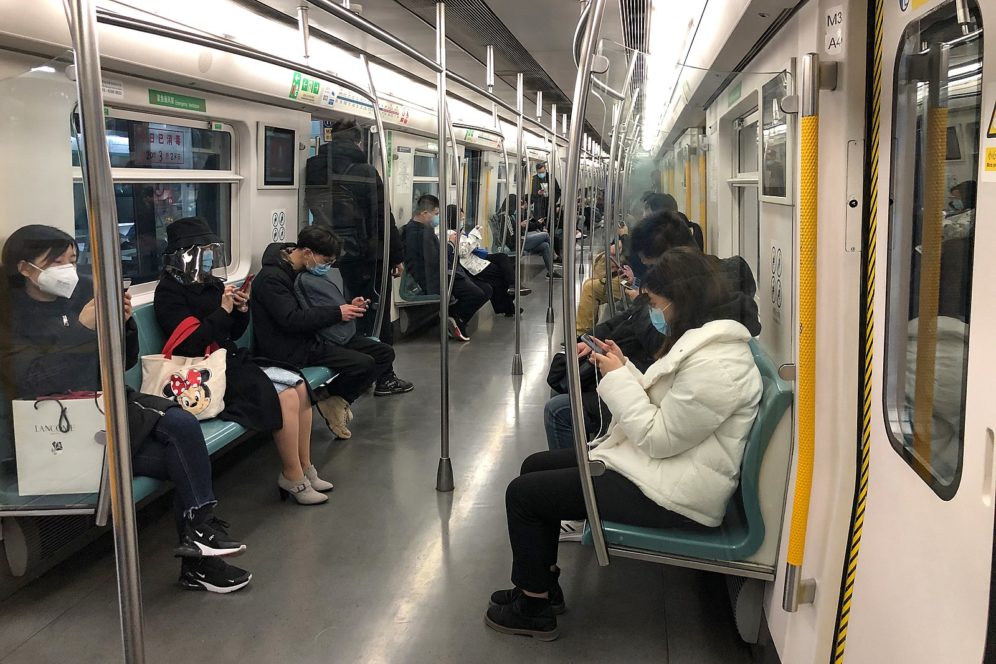
July 03, 2020
How China Kept Transit Running During Covid-19
With the easing of COVID-19 restrictions, governments throughout the world have reopened public transport systems as people have begun to return to work, school, and leisure activities. Still, many cities are struggling with the safe operation of trains, metros, and buses. Passengers seem reluctant to travel in masses, and instead opt for driving, cycling, and walking, or staying home altogether. New York’s MTA cut trains due to shortages of train conductors and low ridership and its typical 24 hour service has been reduced – now the trains do not run between 1am and 5am in order to provide time for cleaning. Mask wearing is not consistently enforced despite being consistently encouraged.
China has experienced a COVID-19 outbreak since January 2020, and implemented successful measures to contain the spread on its public transport services, meet operational challenges, and regain the trust of passengers. Today, public transit has risen to almost pre-COVID-19 ridership, thanks to a cultural norms and coordinated and organized governmental interventions. There is much that can be learned and observed from the operations implemented by Beijing, Shanghai, and Guangzhou.

High public transit ridership returns to Beijing, Shanghai, and Guangzhou
Ridership on cities’ metro and bus systems in seven major cities sharply dropped in the first month of the outbreak, according to statistics from the Evergrande Research Institute. The outbreak of COVID-19 coincided with the start of Spring Festival, China’s major holiday where hundreds of millions return to their home towns across the country, and public transport ridership drops each year. The total passenger volume in the first week of the Spring Festival in 2020 was only 8.8% of that in the same period in 2019, and increased in the fourth week to 22.3%.
Below is a graph of ridership during the Spring Festival, when the lockdowns were at their most extreme and much of the country was sheltering in place.
Ridership numbers are the total of seven major Chinese cities, including Shanghai, Guangzhou, Chengdu, Nanjing, Xi’an, Suzhou and Zhengzhou. Ridership is shown in units of 10,000 passengers on the horizontal axis, for each day after the outbreak of the virus (vertical axis). Ridership on metro systems dropped drastically in 2020 (in blue), compared to 2019 (in orange) but grew over time.
Source: Evergrande Research Institute, 2020
What measures were taken to bring back ridership on public transport?
Lockdowns were not identical across China. In Wuhan, which was the epicenter of the pandemic, people were entirely locked at home and restricted to only essential trips like groceries. Any essential workers moved around in taxis or ubers, bicycles, walking, or employer sponsored cars, this was because Wuhan fully locked down its metro and bus services from January 24 to March 28. Other Chinese cities each implemented their own measures to curb the spread of COVID-19 on public transport, mainly correlated with the number of cases in each city. Beijing, Shanghai, and Guangzhou, which were less severely affected, continued an altered operating schedule of metros and buses, including during the first weeks of the outbreak. By early March, of the 40 Chinese cities with metro services, a total of 8 cities completely suspended operations, 13 cities closed some stations or lines, 30 cities adjusted operating hours, and only 2 cities made no operational adjustments. Beijing’s city government implemented a special work plan for public transport in the first weeks of the epidemic, that was shared with all Chinese city governments by the Ministry of Transport. All cities’ measures were required to center around; Preventing the access and isolation of infected persons, Disinfection and ventilation, and controlling people in the station, on the platform, and throughout train. Below are examples from different major cities in China and from when the outbreak was more severe. Not every measure was adopted by every city, and measures changed overtime as restrictions lessened or were further imposed.
Preventing access of infected persons
In Guangzhou, during the initial outbreak phase, each station deployed an additional 5 to 10 staff to manage the flow of passengers into and out of the station. During busy hours, station managers assigned staff to metro station entrances, and passengers were required to queue outside in open air and with safe distancing. Queuing to enter the station during busy hours was common prior to these security measures, and the additional wait time had not been reported as a deterrent for passengers. Security checks at the entrances have remained. With these checks. the main station hall staff who check body temperatures of each passenger with handheld devices, and check on the compulsory wearing of protective masks. Thermal imaging cameras are deployed at busy station entrances to speed up the process. Until recently, passengers were also required to show staff a personal QR code that proved that their recent exposure to the disease has not deemed them a high-risk passenger. If passengers are detected with body temperatures exceeding 37.3˚C (99˚F), they are taken to the station’s isolation area by staff in PPE suits, where medics escort the passenger to a hospital for further checks. The passenger’s residential community and employer are notified for investigation of close contacts, if needed. Everything the passenger touched is then disinfected. All metro station and train staff wear protective masks and gloves, and body temperatures are monitored at the start and finish of each shift. In case of fever, staff is assigned to a medic for further investigation at a hospital. According to a Guangzhou Metro Corporation employee, none of the staff has been infected.
Above Source: Beijing Municipal Commission of Transport
Disinfection and ventilation
To improve the flow of air, ventilation systems operate in metro stations, platforms, tunnels, and trains at all times. During the first weeks of the outbreak, Beijing’s metro stations were disinfected five times daily, and key infection hot spots such as security screening equipment, ticketing machines, entry gates and elevators were disinfected hourly. In Shanghai, stations near hospitals were disinfected with extra care. Plastic coins used for single tickets are sterilized after each time used.
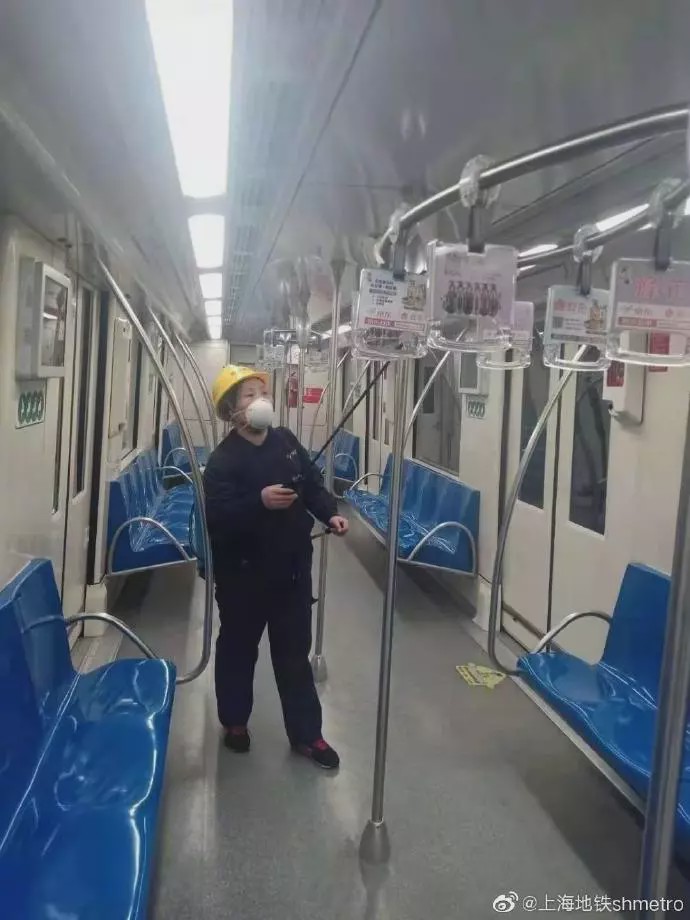
Controlling station, platform, and train occupancies
To reduce crowding, a set of operational measures were adopted. An employee of Guangzhou’s Metro Corporation stated “the most crucial location to prevent crowding is on the platforms. This is where passengers boarding and alighting come in close contact.” During peak hours, additional trains were put into operation, the headway between trains shortened, and stopping times at stations reduced. Express trains were used, only stopping at high-demand and transfer stations, thereby reducing contact of incoming and outgoing passengers. At stations, passengers were separated from oncoming passengers in distinct channels. A number of turnstiles before entering platforms was shut down to allow fewer passengers to enter.
Above Source: Shanghai Shentong Metro Group Co, Ltd
On trains, maximum load capacities were introduced to reduce crowding. In Guangzhou, during the first month of the outbreak, the maximum load capacity was reduced to 50%. In April this went up to 70% and since May back up to 100%. Train drivers have real-time data into the weight (and therefore occupancy) of each carriage and, if the load of passengers among carriages was unevenly distributed, train conductors instruct passengers to spread around and find empty carriages. Beijing passengers are able to see real-time occupancy of carriages on a free app called ‘Metro Full Capacity’ and adapt their travel times accordingly. Baidu Maps, much like Google Maps, also provides real-time occupancy figures. Passengers are asked to travel outside the peak hours as much as possible.
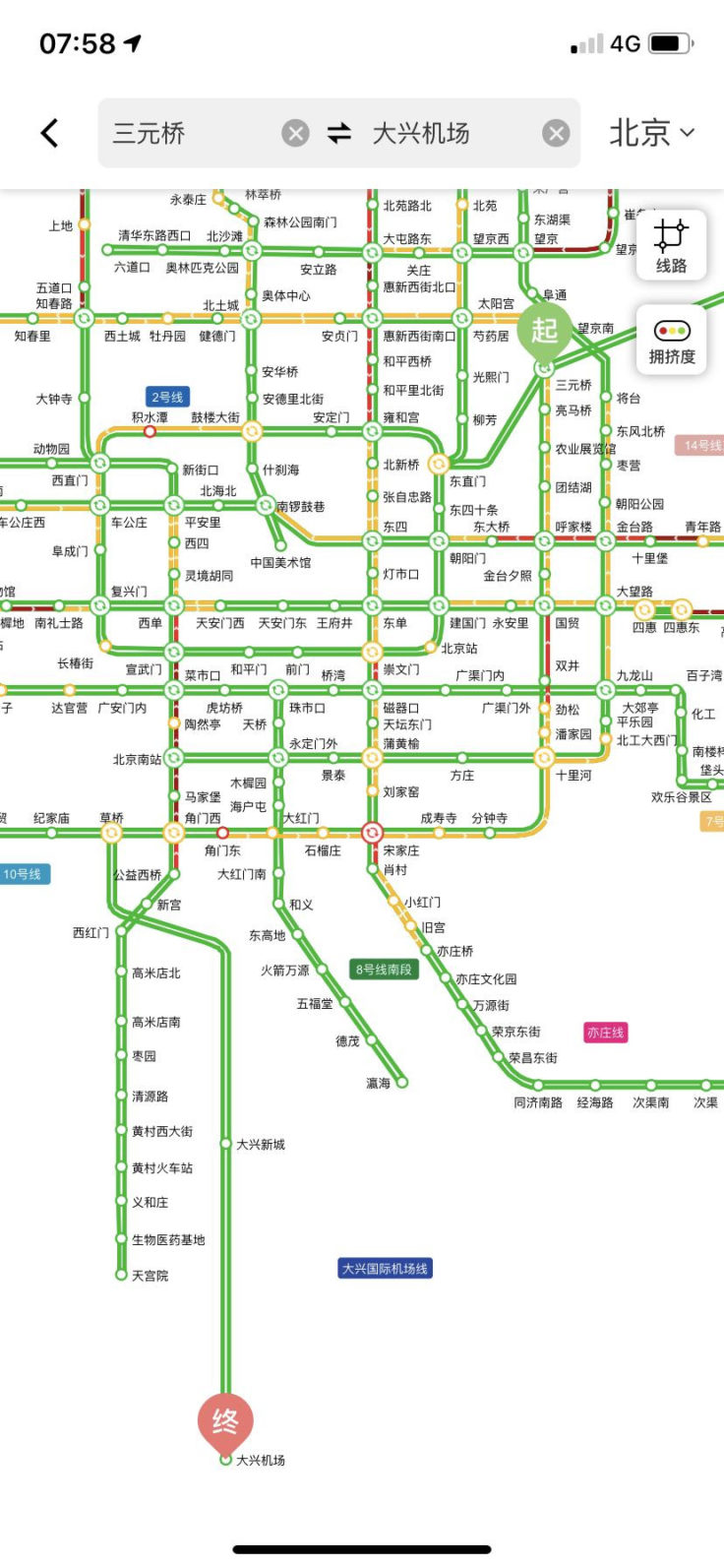
 To improve station access and reduce queuing, two stations in Beijing launched an online reservation system for metro station access during the morning peak hours from 6:30am to 9:30am on weekdays. This measure, which was only available during the initial weeks of the pandemic, was enforced by showing staff QR codes for the reservation.
To improve station access and reduce queuing, two stations in Beijing launched an online reservation system for metro station access during the morning peak hours from 6:30am to 9:30am on weekdays. This measure, which was only available during the initial weeks of the pandemic, was enforced by showing staff QR codes for the reservation.
Awareness campaigns for public health and personal protection are published widespread among station advertisement boards, broadcasts, passenger information systems on trains and social media. Shanghai’s campaign encourages people to follow instructions. Much of the enforcement within the stations is focused on encouraging passengers to move to less crowded cars or less crowded areas in the stations.
COVID-19 Measures on Buses
Measures on bus transport followed a similar pattern as for metros for the first few months of the outbreak. Passengers’ body temperatures were taken by the bus driver upon entry. If a boarding passenger’s temperature were to exceed 37.3˚C (99˚F), the bus driver immediately called a special hotline, and a nearby police officer was dispatched to accompany the passenger to a nearby hospital for further investigation. The buses opened all windows and shut down air-conditioning. At BRT stations, a similar approach was used as for metros, where station entrance is controlled and platform crowding minimized.
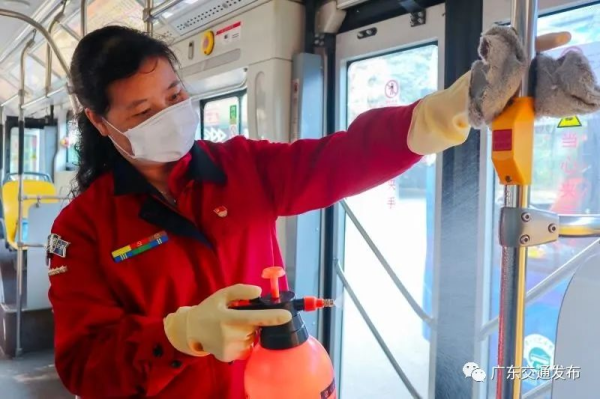
Challenges
When speaking to metro operators across China, the main challenge was handling the financial effects of reduced ridership revenue and increased costs of implementing the COVID-19 prevention measures. However, since nearly all metro lines in China are operated by state-owned companies, this did not affect the quality of operation. Operational challenges for the metro corporation and station staff were due to the frequently changing nature of the safety protocols and requirements. Guangzhou Metro staff mentioned that they “had gone through trainings for fires and other emergencies, but not for a pandemic outbreak. It was challenging to adapt to continuously changing situations. The city government would update the ‘threat level’ each day, based on the number and locations of new COVID-19 cases. With each ‘threat level’, stricter or looser measures were to be taken. It was challenging to re-organize ourselves each day, and update passenger flows and communication messages. Additional station staff would be deployed to stations in districts where new outbreaks were found. Another challenge was the continuous, thorough disinfection of the stations.”
Due to the closing of lines and stations, metro staff could often be reassigned. Close cooperation with medical teams and police made it possible to handle passengers with a fever, and passengers who were unwilling to cooperate with metro station staff. There is a cultural acceptance in China of focusing less on the freedoms and comforts of the individual and more on the common good for all people. There is a sense that what is best for the group is more important than an individual’s preferences. This helps underscore how some measures, so successful in China, would be more difficult to enact in cultures that are more individualistic (like those in the West).
Interviews with metro passengers showed that passengers were initially afraid of taking the metro in the first month of the COVID-19 outbreak. Many were told to work from home and any essential trips were taken without the metro. One Guangzhou resident, Miss Wang, started using DiDi, China’s Uber, for shorter trips, albeit had no choice but to take the metro for longer trips into the center of Guangzhou. She explained to ITDP, “I was scared of taking the metro, did not talk to anyone, and tried not to touch anything. Everything was very clean though, and it smelled like disinfectant. The Guangzhou metro used to be lively, and people would chat, but now it is eerily quiet. The metro is busy again now, but I am glad it is a little quieter than before.” When no new COVID-19 cases emerged in March, a Beijing resident, Miss Li felt enough to confident to take the metro again. She explained, “I had no other option than taking the metro; buses and DiDis are always stuck in traffic during peak hours. I was still afraid of taking the metro, but would take a train at 8:30am instead of 8:00am, to evade the busiest time. It was much less crowded, and I felt ok. I never waited for more than two minutes to enter the station. I don’t like wearing a mask, but it is better for my own and everyone else’s protection.” Miss Wang said she is impressed with the metro staff, who “do a great job managing the stations and keeping everything clean, showing passengers that they’re doing everything they can to curb the spread of COVID-19.”
A key factor in the successful implementation of the measures, is the accountability of officials. Metro officials cannot afford the spread of COVID-19 under their watch, since this has serious impacts on their professional careers.
Public Transport Ridership Return
While ridership rates are not what they were in 2019, there is a gradual return to public transit. In Guangzhou, ridership initially dropped from 9 million daily trips to 3 million daily trips during the first month of the pandemic. By May, however, ridership has increased to over 7 million trips everyday. An ITDP survey in Guangzhou found that some of these trips may never return, at this point some passengers have switched to cycling and cars.
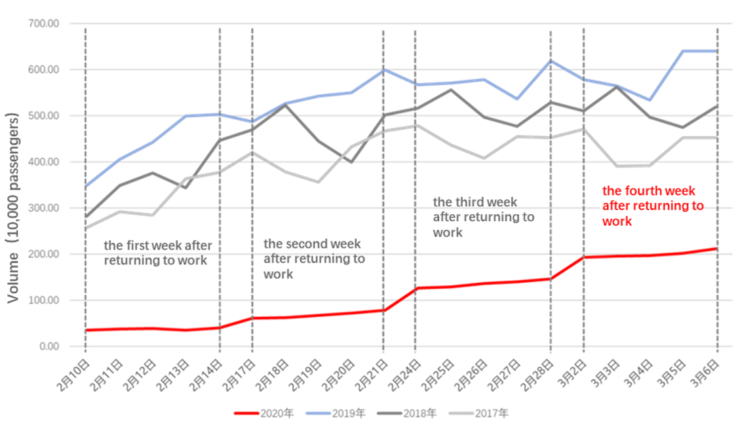

As of this writing, China’s cities have largely gone ‘back to normal.’ Work has resumed, offices have reopened, and school and nurseries, which were the last to reopen, did so towards the end of May and early June.
Transit ridership in Chinese cities dropped dramatically in the first weeks of the epidemic, due to lockdowns but also due to the fear of infection from being in an enclosed space with others. However, the wide range of public safety and operational measures have supported the ridership rebound on public transport. Other cities can learn valuable lessons from Chinese cities that have already been through the worst part of the epidemic. It proves that public transport remains crucial to the mix of urban transport, and essential in bringing employees to reopening workplaces, schools and shops.

